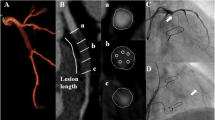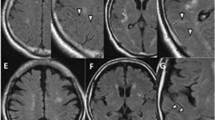Abstract
Background
Carotid artery stenting (CAS) is associated with a higher risk of periprocedural stroke than carotid endarterectomy. For better patient selection, more accurate risk factors should be identified. The aim of this study was to determine whether expansive arterial remodeling can predict ischemic complications in patients undergoing CAS.
Methods
This retrospective study included 82 patients with carotid stenosis treated by CAS. The plaque component was evaluated using MR plaque imaging before the procedure. Following the procedure, lesion assessment was performed using MRI diffusion-weighted imaging (DWI), and patients were classified as DWI positive or negative for comparison between groups.
Results
Fifteen patients were classified as DWI positive and 67 patients as DWI negative. The mean expansive remodeling rate was 1.76 ± 0.21 in the DWI-positive group and 1.35 ± 0.18 in the DWI-negative group (P < 0.001). Receiver-operating characteristic analysis revealed that the threshold for the expansive remodeling rate separating the two groups was 1.52 (area under the curve = 0.933). The positive predictive value of postoperative new DWI lesions in the high-intensity plaque associated with a high expansive remodeling rate was 64.3%, and the negative predictive value of the isointensity plaque associated with a low expansive remodeling rate was 97.8%. These values were higher than those of the plaque component alone (32.1% and 81.7%, respectively).
Conclusions
This study revealed that expansive arterial remodeling is a strong risk predictor of ischemic complication in CAS. Expansive remodeling rate measurements are very simple and provide useful information for determining treatment strategies for patients with carotid stenosis.



Similar content being viewed by others
References
Akutsu N, Hosoda K, Fujita A, Kohmura E (2012) A preliminary prediction model with MR plaque imaging to estimate risk for new ischemic brain lesions on diffusion-weighted imaging after endarterectomy or stenting in patients with carotid stenosis. AJNR Am J Neuroradiol 33:1557–1564
Brott TG, Hobson RW 2nd, Howard G, Roubin GS, Clark WM, Brooks W, Mackey A, Hill MD, Leimgruber PP, Sheffet AJ, Howard VJ, Moore WS, Voeks JH, Hopkins LN, Cutlip DE, Cohen DJ, Popma JJ, Ferguson RD, Cohen SN, Blackshear JL, Silver FL, Mohr JP, Lal BK, Meschia JF, Investigators C (2010) Stenting versus endarterectomy for treatment of carotid-artery stenosis. N Engl J Med 363:11–23
Siddiq F, Adil MM, Malik AA, Qureshi MH, Qureshi AI (2015) Effect of carotid revascularization endarterectomy versus stenting trial results on the performance of carotid artery stent placement and carotid endarterectomy in the United States. Neurosurgery 77:726–732 discussion 732
European Carotid Surgery Trialists' Collaborative Group (1998) Randomised trial of endarterectomy for recently symptomatic carotid stenosis: final results of the MRC European Carotid Surgery Trial (ECST) Lancet 351:1379–1387
Biasi GM, Froio A, Diethrich EB, Deleo G, Galimberti S, Mingazzini P, Nicolaides AN, Griffin M, Raithel D, Reid DB, Valsecchi MG (2004) Carotid plaque echolucency increases the risk of stroke in carotid stenting: the imaging in carotid angioplasty and risk of stroke (ICAROS) study. Circulation 110:756–762
Lanzer P, Weser R, Prettin C (2006) Carotid-artery stenting in a high-risk patient population—single centre, single operator results. Clin Res Cardiol 95:4–12
Mathur A, Roubin GS, Iyer SS, Piamsonboon C, Liu MW, Gomez CR, Yadav JS, Chastain HD, Fox LM, Dean LS, Vitek JJ (1998) Predictors of stroke complicating carotid artery stenting. Circulation 97:1239–1245
Safian RD, Bresnahan JF, Jaff MR, Foster M, Bacharach JM, Maini B, Turco M, Myla S, Eles G, Ansel GM, Investigators CPT (2006) Protected carotid stenting in high-risk patients with severe carotid artery stenosis. J Am Coll Cardiol 47:2384–2389
Kurosaki Y, Yoshida K, Fukumitsu R, Sadamasa N, Handa A, Chin M, Yamagata S (2016) Carotid artery plaque assessment using quantitative expansive remodeling evaluation and MRI plaque signal intensity. J Neurosurg 124:736–742
Yoshida K, Fukumitsu R, Kurosaki Y, Funaki T, Kikuchi T, Takahashi JC, Takagi Y, Yamagata S, Miyamoto S (2015) The association between expansive arterial remodeling detected by high-resolution MRI in carotid artery stenosis and clinical presentation. J Neurosurg 123:434–440
Kashiwazaki D, Akioka N, Kuwayama N, Noguchi K, Tanaka K, Kuroda S (2015) Pathophysiology of acute cerebrovascular syndrome in patients with carotid artery stenosis: a magnetic resonance imaging/single-photon emission computed tomography study. Neurosurgery 76:427–433
O’Rourke MF, Hashimoto J (2007) Mechanical factors in arterial aging: a clinical perspective. J Am Coll Cardiol 50:1–13
Nakamura M, Nishikawa H, Mukai S, Setsuda M, Nakajima K, Tamada H, Suzuki H, Ohnishi T, Kakuta Y, Nakano T, Yeung AC (2001) Impact of coronary artery remodeling on clinical presentation of coronary artery disease: an intravascular ultrasound study. J Am Coll Cardiol 37:63–69
Varnava AM, Mills PG, Davies MJ (2002) Relationship between coronary artery remodeling and plaque vulnerability. Circulation 105:939–943
Rodriguez-Granillo GA, Serruys PW, Garcia-Garcia HM, Aoki J, Valgimigli M, van Mieghem CA, McFadden E, de Jaegere PP, de Feyter P (2006) Coronary artery remodelling is related to plaque composition. Heart 92:388–391
Takemoto K, Ueba T, Takano K, Abe H, Hirata Y, Higashi T, Inoue T, Sakata N, Yoshimitsu K (2013) Quantitative evaluation using the plaque/muscle ratio index panels predicts plaque type and risk of embolism in patients undergoing carotid artery stenting. Clin Neurol Neurosurg 115:1298–1303
Author information
Authors and Affiliations
Corresponding author
Ethics declarations
Funding
All authors received no funding for this research.
Conflict of interest
None.
Ethical approval
For this type of study, formal approval is not required.
Informed consent
Informed consent was obtained from all individual patients included in this study.
Additional information
Comments
This is a sage and salient contribution from a highly experienced carotid surgery group. The message is clear; high-risk plaques with extensive remodeling have a materially higher risk of new DWI lesions post-CAS. These data can guide us all to best stratify and optimize patients for surgery or CAS. My only criticism is that the majority of the patients were asymptomatic, and if they had co-morbidities that would otherwise render them high-risk (not discussed in this article), many of us experienced in carotid reconstruction would consider observational treatment alone for this class of patients.
Christopher Miranda Loftus
PA, USA
Rights and permissions
About this article
Cite this article
Kashiwazaki, D., Kuwayama, N., Akioka, N. et al. Carotid plaque with expansive arterial remodeling is a risk factor for ischemic complication following carotid artery stenting. Acta Neurochir 159, 1299–1304 (2017). https://doi.org/10.1007/s00701-017-3188-y
Received:
Accepted:
Published:
Issue Date:
DOI: https://doi.org/10.1007/s00701-017-3188-y




